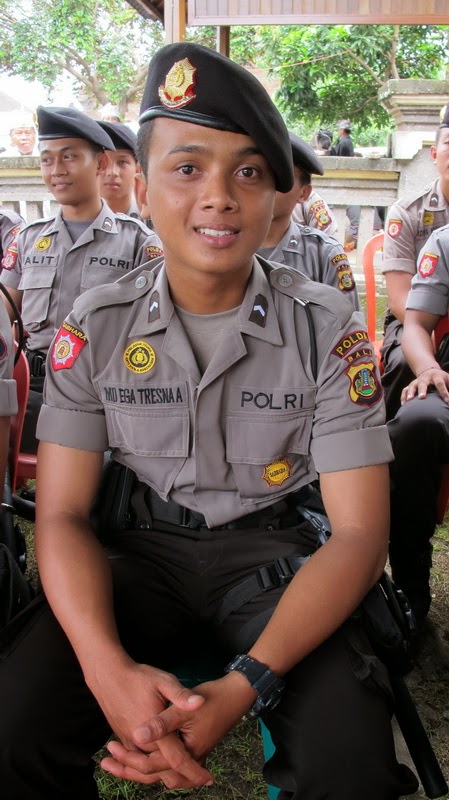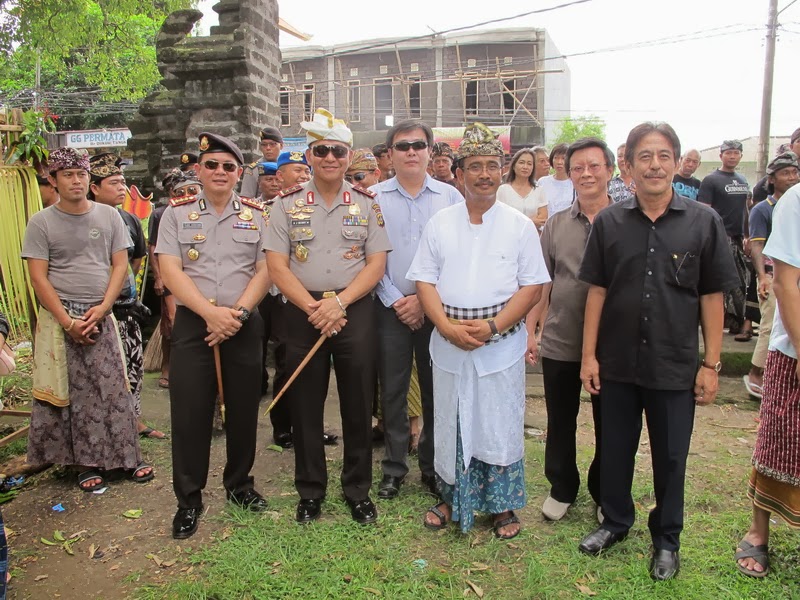 Architecturally-exciting entrance to the National Portrait Gallery, Canberra |
Canberra - Cirebon
After New Year’s in Sydney I went to Canberra to see the fairly new National Portrait gallery, a remarkable building designed by Australian architect Richard Johnson who is something of a museum maestro. I stayed in nearby Yass on a friend’s stud farm. One sure way of experiencing a country's real culture is to stay in the bush. In Australia one can choose to experience the popular mid-20th Century Hoon culture – beer-swelling, bull-dogging and chick-baiting – or the more refined squatocracy culture – horsey folk in Ralph Lauren casuals with side lines in artisanal olive oil and such. Today's Australian country squire is still handsome and rugged – think Hugh Jackman in Australia – but comes home from the fields early to watch Downtown Abbey. My Balinese travelling companion got to see parliament after parliament of kangaroos in the pastures near the house and eat lots of the excellent local red meat.
 |  |
The Balinese are much better travellers than the Jakartans I have observed.
The week before I took my Balinese friend to Bondi beach where we found tribes of Jakartan tourists refusing to take off their shoes. This was quite funny for me as I have always maintained that Jakartan architects are not so good at designing beach resorts in Bali because they have never walked on a beach with bare feet. Ha! Non-urban Indonesians can't catch a bus inter-island without donning three sweaters and carrying a ton of provisions just in case the bus doesn't stop for a week or so.
The week before I took my Balinese friend to Bondi beach where we found tribes of Jakartan tourists refusing to take off their shoes. This was quite funny for me as I have always maintained that Jakartan architects are not so good at designing beach resorts in Bali because they have never walked on a beach with bare feet. Ha! Non-urban Indonesians can't catch a bus inter-island without donning three sweaters and carrying a ton of provisions just in case the bus doesn't stop for a week or so.
Indonesian Haj pilgrims are now famous at Changi Airport for their outlandish attire. During the haj season (this month it seems) there are orderly gangs of pilgrims – orderly in the sense that they move ever so slowly in large groups, clogging up all the door exits – in the usual Haj attire – white turbans and moo-moos etcetera – but with fluorescent lime green or bright pink batik-look shirts sort of interwoven into their elegant haj-wear. Sadly, real batik is too ethnic for the modern Muslim: Java is now a sea of batik-look moo-moos.
• • •
I have always wanted to visit one of Java’s old Chinese temples, on Chinese New Year.
At the beginning of February I was in Jakarta so I decided to catch a train to Cirebon to visit the 15th Century Tiao Kak Sie Klenteng while at the same time visiting Indonesia’s oldest palace, the Kraton Kasepuhan, and the old mosque, and the beautiful tomb of Sunan Gunung Jati.
At the beginning of February I was in Jakarta so I decided to catch a train to Cirebon to visit the 15th Century Tiao Kak Sie Klenteng while at the same time visiting Indonesia’s oldest palace, the Kraton Kasepuhan, and the old mosque, and the beautiful tomb of Sunan Gunung Jati.
 | |
 |  |
Kraton Kasepuhan, Cirebon, West Java
| |
Gambir station has had a major make-over since I last took a train, in 1988 — it’s all spic and span, now, and even has a Starbucks.
The executive trains are comfortable and clean and run on time. I caught the 9 a.m. Argo Mulio, and I was in Cirebon in under two and a half hours.
I stayed at the Santika hotel near the station which was very pleasant; the hotel kindly arranged an hourly Innova and I was soon at theklenteng admiring a sea of giant red candles.
The executive trains are comfortable and clean and run on time. I caught the 9 a.m. Argo Mulio, and I was in Cirebon in under two and a half hours.
I stayed at the Santika hotel near the station which was very pleasant; the hotel kindly arranged an hourly Innova and I was soon at theklenteng admiring a sea of giant red candles.
 | |
 Barong Sai dancer preparing the barong at Klenteng Tiao Kak Sie (established around the mid-15th century over the ruins of the old Hanafi Chinese Muslim mosque) |  Klenteng worker at Klenteng Tiao Kak Sie, Cirebon |
The atmosphere inside the multi-courtyard klenteng was not unlike a Balinese temple during preparations for a festival: youths busied themselves decorating and preening the Barong Sai while priests prepared the offerings. I was told to come back at 9 p.m. for the candle-lighting and pork-fest.
I returned to the Santika via the 15th Century Keraton Kasepuhan Palace formerly the Pakungwati Palace of the great Sunan Gunung Jati himself.
I returned to the Santika via the 15th Century Keraton Kasepuhan Palace formerly the Pakungwati Palace of the great Sunan Gunung Jati himself.
 The Sitinggil court of the Keraton Kasepuhan, Cirebon | |
Singa Barong |  Chinese dragon carvings |
 19th century Gajahmina palanquin in the Keraton Kasepuhan Museum | |
(See Video: http://www.youtube.com/watch?v=_q2C2alG7bU)
The palace is the only surviving palace of the Majapahit Era — its construction having been supervised by builders and architects from the great Hindu empire in East Java. The outer Sitinggil court is a masterpiece of red-brick architecture and exquisitely carved pavilions. In the palace museum I found the legendary 15th Century Singa Barong coach which — with its elephant body, Chinese dragon carvings and Islamic Baroque wings — symbolizes the three predominate cultures of Cirebon.
Around the corner is the equally magnificent and equally old Masjid Agung Cipta Rasa which has a fine collection of Majapahit timber pavilions and carving.
Around the corner is the equally magnificent and equally old Masjid Agung Cipta Rasa which has a fine collection of Majapahit timber pavilions and carving.
 | |
Cirebon matinee idol, Elang Deri Kusuma, in situ guarding at his ancestor Sunan Gunung Jati’s tomb, Cirebon
| |
(See video: http://youtu.be/w8i3Mk0W6Bk)
• • •
The next morning I visited the tomb (makam) of Sunan Gunung Jati, Cirebon’s first sultan and a much revered Muslim saint on the North Coast Java Wali Songo circuit.
The tomb is the most exotic in Java — nine terraces of Cirebon-rococo splendour. I was very lucky to get into the section normally reserved for palace family members (to this day the Kanoman Palace still looks after the complex, with 108 guardians) and to see the beautifulcungkup (tomb room) of the fabled Sunan on the hill’s peak. The carvings on the cungkup’s main door are of a Majapahit magnificence I had only dreamed of, replete with surya (sun) motif on the lintel and chain carvings on the architrave (an Islamic-era Majapahit classic, symbolizing the unification of the Islamic sects).
The gardens and Chinese tile decorated gates are astounding too.
The tomb is the most exotic in Java — nine terraces of Cirebon-rococo splendour. I was very lucky to get into the section normally reserved for palace family members (to this day the Kanoman Palace still looks after the complex, with 108 guardians) and to see the beautifulcungkup (tomb room) of the fabled Sunan on the hill’s peak. The carvings on the cungkup’s main door are of a Majapahit magnificence I had only dreamed of, replete with surya (sun) motif on the lintel and chain carvings on the architrave (an Islamic-era Majapahit classic, symbolizing the unification of the Islamic sects).
The gardens and Chinese tile decorated gates are astounding too.
 Gate to the tomb of Sunan Gunung Jati, Cirebon. Note the Ming era decorative tile accents imported by local Hanafi Muslim Chinese from the late 14th century onwards | |
 Surya (sun) Majapahit motif on door lintel of Sunan Gunung Jati’scungkup (tomb room) Surya (sun) Majapahit motif on door lintel of Sunan Gunung Jati’scungkup (tomb room) |  Chain carvings on the architrave |
(See Video: http://www.youtube.com/watch?v=tF-dVhHC4NQ)
• • •
Back at base camp — that is, the guardians’ quarters at the hill’s bottom — I witness a procession heading out to fetch the flowers to be used for Friday’s Nyekah rituals at the palace ancestors’ graves.
Prayer tune at the Masjid Sang Cipta Rasa, Java’s oldest mosque |  Friday’s routine fetching of the flowers (sekar) ritual, Makam Sunan Gunung Jati |
A giant marquee is going up for the afternoon’s mass circumcision (50 teenage boys). In a corner court village ladies wrapped in batiks (yes, batiks, in public, in Java!) were taking energizing baths at the tomb’s holy well (Sumur Bayu Jati).
The atmosphere is identical to a Balinese temple festival in full swing, but with donation collectors with plastic buckets every three meters or so.
From the tomb complex I go to the old palace pleasure gardens on the outskirts of town.
The atmosphere is identical to a Balinese temple festival in full swing, but with donation collectors with plastic buckets every three meters or so.
From the tomb complex I go to the old palace pleasure gardens on the outskirts of town.
 | |
Taman Gua Sunyaragi, the Keraton Kasepuhan’s harem and pleasure gardens, a masterpiece of gunungan architectural style
| |
(See Video: http://www.youtube.com/watch?v=j7XrI8mYFJ8)
The area was once a lake: the vast ‘gunungan’ grotto complex with attendant meditation pavilion pinnacle would have once risen from the shimmering water like a mystical mountain.
Today the gardens are a magnet for teenagers with heaving hormones. Love poems are plastered all over the cave walls; couples canoodle in the exquisite Cirebon-rococo pavilions.
Today the gardens are a magnet for teenagers with heaving hormones. Love poems are plastered all over the cave walls; couples canoodle in the exquisite Cirebon-rococo pavilions.
 Sexy art on a fishing boat at Cirebon Harbour |
• • •
 Painting of the old Masjid Kauman and photos of what's left of the 15th Century Masjid Sekayu. | |
 |  |
Old Mosques of Semarang | |
From Cirebon I caught another excellent train to Semarang and then Wings (Lion Air affiliate) straight to Bali the next morning.
In Semarang I stayed at the Novotel which was excellent. The hotel’s parking attendant took me across the road to Kampung Sekayu, one of Semarang’s oldest, where the bones (columns and tie beams) of another 15th Century mosque survive.
In Semarang I stayed at the Novotel which was excellent. The hotel’s parking attendant took me across the road to Kampung Sekayu, one of Semarang’s oldest, where the bones (columns and tie beams) of another 15th Century mosque survive.














































